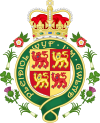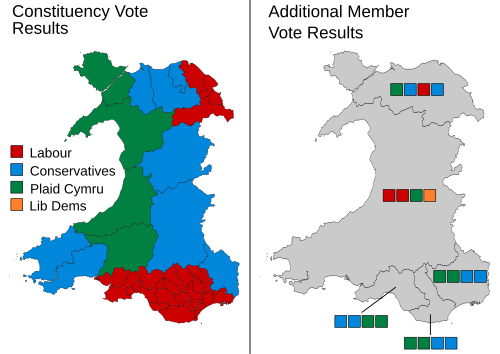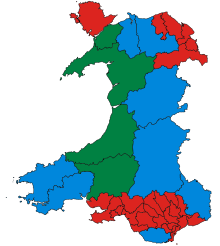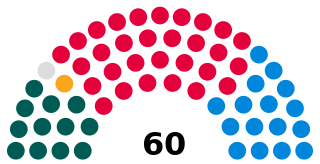
A member of the Senedd is a representative elected to the Senedd. There are sixty members, with forty members chosen to represent individual Senedd constituencies, and twenty to represent the five electoral regions of the Senedd in Wales.

The Senedd, officially known as the Welsh Parliament in English and Senedd Cymru in Welsh, is the devolved, unicameral legislature of Wales. A democratically elected body, it makes laws for Wales, agrees to certain taxes, and scrutinises the Welsh Government. It is a bilingual institution, with both Welsh and English being the official languages of its business. From its creation in May 1999 until May 2020, the Senedd was officially known as the National Assembly for Wales and often simply called the Welsh Assembly.

The Wales Green Party is a semi-autonomous political party within the Green Party of England and Wales (GPEW). It covers Wales, and is the only regional party with semi-autonomous status within the GPEW. The Wales Green Party puts up candidates for council, Senedd, and UK Parliament seats.

Politics in Wales forms a distinctive polity in the wider politics of the United Kingdom, with Wales as one of the four constituent countries of the United Kingdom (UK).
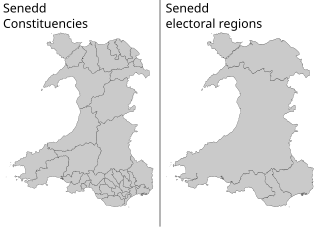
The Senedd constituencies and electoral regions are the electoral districts used to elect members of the Senedd to the Senedd, and have been used in some form since the first election of the then National Assembly for Wales in 1999. New boundaries were introduced for the 2007 elections and currently consist of forty constituencies and five regions. The five electoral regions are: Mid and West Wales, North Wales, South Wales Central, South Wales East, and South Wales West, with the forty constituencies listed below. Voting last took place in all districts in the 2021 Senedd election, and is not used for local government.

South Wales Central is an electoral region of the Senedd, consisting of eight constituencies. The region elects 12 members, eight directly elected constituency members and four additional members. The electoral region was first used in 1999, when the National Assembly for Wales was created.

Cardiff West is a constituency of the Senedd. It elects one Member of the Senedd by the first past the post method of election. Also, however, it is one of eight constituencies in the South Wales Central electoral region, which elects four additional members, in addition to eight constituency members, to produce a degree of proportional representation for the region as a whole. The constituency has twice provided the First Minister of Wales, Rhodri Morgan from 2000-2009 and Mark Drakeford from 2018–2024.

Cardiff Central is a constituency of the Senedd. It elects one Member of the Senedd by the first past the post method of election. Also, however, it is one of eight constituencies in the South Wales Central electoral region, which elects four additional members, in addition to eight constituency members, to produce a degree of proportional representation for the region as a whole.

Aberavon is a constituency of the Senedd. It elects one Member of the Senedd by the first past the post method of election. Also, however, it is one of seven constituencies in the South Wales West electoral region, which elects four additional members, in addition to seven constituency members, to produce a degree of proportional representation for the region as a whole.
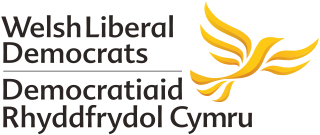
The Welsh Liberal Democrats are a branch of the United Kingdom Liberal Democrats that operates in Wales. The party is led by Jane Dodds, who served as MP for Brecon and Radnorshire from August to December 2019, and MS for Mid and West Wales since May 2021. The party currently has 1 elected member in the Senedd and no Welsh seats in the UK House of Commons, but does have several members of the House of Lords. The party had 69 local councilors serving in principal authorities as of the 2022 local authority elections, up 10 from 2017.

The 2011 National Assembly for Wales election was an election for the National Assembly. The poll was held on 5 May 2011 and decided the incumbency for all the Assembly's seats. It was the fourth election for seats in the National Assembly for Wales, and the second election taken under the rules of the Government of Wales Act 2006.
Politics of Cardiff refers to the political representation of the city of Cardiff, capital of Wales. Cardiff is represented politically at a local, Wales and United Kingdom level and previously at the European level.

There are five types of elections in the United Kingdom: elections to the House of Commons of the United Kingdom, elections to devolved parliaments and assemblies, local elections, mayoral elections, and police and crime commissioner elections. Within each of those categories, there may also be by-elections. Elections are held on Election Day, which is conventionally a Thursday, and under the provisions of the Dissolution and Calling of Parliament Act 2022 the timing of general elections can be held at the discretion of the prime minister during any five-year period. All other types of elections are held after fixed periods, though early elections to the devolved assemblies and parliaments can occur in certain situations. The five electoral systems used are: the single member plurality system (first-past-the-post), the multi-member plurality, the single transferable vote, the additional member system, and the supplementary vote.

The 2016 National Assembly for Wales election was held on Thursday 5 May 2016, to elect members (AMs) of the National Assembly for Wales, now known as the Senedd. It was the fifth election for the National Assembly, the third election taken under the rules of the Government of Wales Act 2006 and the first since the Wales Act 2014.
The Abolish the Welsh Assembly Party, or in Wales, simply Abolish, is a registered single issue political party in Wales. It campaigns for the abolition of the Senedd, formerly known as the "National Assembly for Wales", the devolved legislature of Wales. Abolish advocates that devolved powers be returned to the Secretary of State for Wales within the UK Central Government and the Parliament of the United Kingdom at Westminster.

Neil John McEvoy is a Welsh nationalist politician, serving as leader of Propel since 2020, and as a Cardiff Councillor for the Fairwater ward since 2008.

The 2021 Senedd election took place on Thursday 6 May 2021 to elect 60 members to the Senedd. It was the sixth devolved general election since the Senedd was established in 1999. The election was held alongside the Scottish Parliament election, English local elections, London Assembly and mayoral election and the Hartlepool by-election.

Gwlad is a centre-right Welsh nationalist and pro-independence political party. Its current leader is Gwyn Wigley Evans.
The next Senedd election is due to be held on or before 7 May 2026 to elect 96 members to the Senedd. It will be the seventh devolved general election since the Senedd was established in 1999. It will also be the second election since the Senedd changed its name in May 2020, and the first following reforms to the voting system which increased the size of the Senedd from 60 members to 96 and shortened its term from five years to four.
The Senedd Cymru Bill was introduced on 18 September 2023 to take forward proposals to expand and reform the Senedd in Wales. Proposals included created sixteen larger constituencies, each electing six members of the Senedd (MSs) by proportional representation. It was hoped to approve the bill in time to take effect from the 2026 Senedd election.
